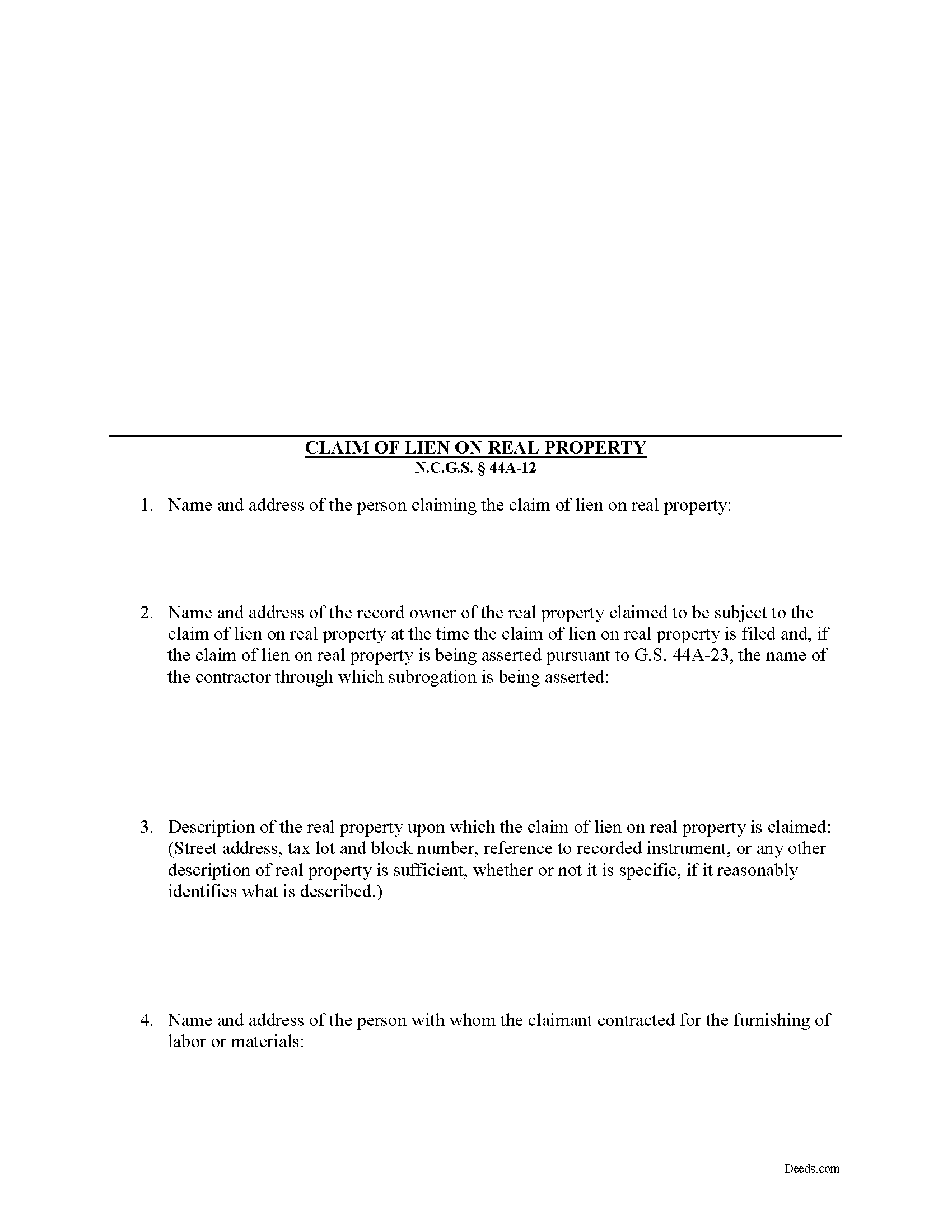Download North Carolina Claim of Mechanics Lien Legal Forms

North Carolina Claim of Mechanics Lien Overview

Filing a Mechanic's Lien in North Carolina
Mechanic's liens are used to enforce the terms of payment in a contract when the amount that's owed remains unpaid by the property owner or other contractors in the chain. The lien operates by putting a "block" on the owner's title so that he or she will find it difficult to sell or refinance the property without first resolving the lien. In turn, the lienholder has the power to foreclose, or force a sale on the property to recover money owed. In North Carolina, potential claimants can obtain a mechanic's lien by filing a Claim of Lien on Real Property in accordance with the statutory requirements.
Claims of lien on real property may be filed at any time after the obligation matures, but no later than 120 days after the final furnishing of labor or materials at the site of the improvement by the person claiming the lien. N.C.G.S. 44A-12(b).
Unlike in many states where lien claims are recorded in a land records office, all claims of lien on real property must be filed in the office of the clerk of superior court in each county where the real property subject to the claim of lien on real property is located. N.C.G.S. 44A-12(a). The clerk of superior court shall note the claim of lien on real property on the judgment docket, and index the same under the name of the record owner of the real property at the time the claim of lien on real property is filed. Id. An additional copy of the claim of lien on real property may also be filed with any receiver, referee in bankruptcy or assignee for benefit of creditors who obtains legal authority over the real property. Id.
The Claim of Lien form must contain the following information about the contracting parties and the subject property: (1) the name and address of the person claiming the claim of lien; (2) the name and address of the record owner of the real property subject to the claim of lien at the time, and, if the claim of lien on real property is being asserted pursuant to G.S. 44A-23 (subcontractor's claims), the name of the contractor through which subrogation is being asserted; (3) a description of the real property for which the claim of lien on real property is claimed (street address, tax lot and block number, reference to recorded instrument, or any other description of real property is sufficient if it reasonably identifies what is described); (4) the name and address of the person with whom the claimant contracted for the furnishing of labor or materials; (5) the date labor or materials were first furnished upon the property by the claimant; (5a) the date labor or materials were last furnished upon the property by the claimant; and (6) a general description of the labor performed or materials furnished and the amount claimed. N.C.G.S. 44A-12(c).
Be careful when completing the form, because a claim of lien on real property may not be amended. N.C.G.S. 44A-12(e). It can, however, be cancelled by a claimant or the claimant's agent or attorney, and a new claim of lien on the real property can be substituted if it's filed within the time provided for the original filing. Id.
Once the lien is in place, it must be enforced within the provided time or it will expire. A lien is enforced by foreclosing on the property to recover the amount owed. An action to enforce a claim of lien on real property may be commenced in any county where venue is otherwise proper. N.C.G.S. 44A-13(a). No such action may be commenced more than 180 days after the last furnishing of labor or materials at the site of the improvement by the person claiming the claim of lien on real property. Id. A judgment enforcing a lien may be entered for the principal amount due which cannot exceed the principal amount stated in the claim of lien. N.C.G.S. 44A-13(c). The judgment then forces a sale of the real property subject to the lien. Id.
Liens grow old and expire, so claimants must pay attention to significant dates. If a lien claimant fails to file a suit to enforce the lien or fails to file an answer in a pending suit to enforce a lien within 30 days after a properly served written demand of the owner, lienee, or other authorized agent, the lien will be extinguished. N.C.G.S. 44A-24.10. Liens must also be released when the underlying obligation has been satisfied. If a claim for a lien has been filed with the clerk of superior court and the claim has been paid in full, or if the lien claimant fails to institute a suit to enforce the lien within the time as provided by law, the lien claimant must acknowledge satisfaction or release of the lien in writing upon written demand of the owner promptly, and in no event more than 30 days after the demand. N.C.G.S. 44A-24.11.
This article is provided for informational purposes only and should not be relied upon as a substitute for the advice of a legal professional. Please contact a North Carolina attorney with any questions about filing a claim of lien on real property.